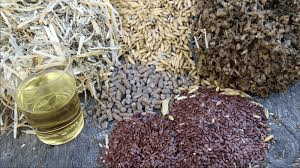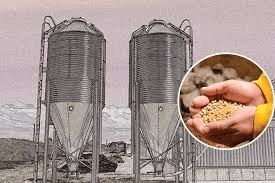Most stored animal feedstuffs undergo some chemical changes altering flavor and nutritive value. These changes are usually deteriorative in nature and are associated with the lipid content of the feedstuffs. Lipids tend to break down during storage into free fatty acids.
Factors Affecting Deteriorative Processes in Stored Animal Feedstuffs
1. Environmental factors
Environmental factors that determine the extent of deterioration of stored feedstuffs al so affect the rate of growth of its insect and microbial population. These include ambient temperature and relative humidity.
Other environmental factors relate to the general cleanliness of the storage areas and to design features of the storage building; e.g., p rotection against rain and insulation against scavenger pests.
2. Insects and micro-organisms
The role that insects and micro-organisms play in the breakdown of lipids in the feedstuffs they attack has been discussed earlier. The increase of fatty acids as a result of lipid breakdown is of particular importance in the storage of fish meal, cereal brans, and oil seed derivatives; e.g., copra, groundnut, and palm kernel meal. This increase in free fatty acids in improperly stored feedstuffs results in rancidity.
3. Rancidity
There are three major chemical processes that give rise to rancidity: oxidation, hydrolysis, and ketone formation. Due to the relative unimportance of the other two processes in stored feedstuffs only oxidation of fats will be described here.
4. Lipid oxidation
Rancidity resulting from lipid oxidation is the most important deteriorative change occurring in stored feedstuffs. Feedstuffs containing lipids which are highly unsaturated (e.g., rice bran and fish meal), are especially susceptible to oxidation.
The mechanism of lipid oxidation begins with auto-oxidation involving the direct reaction of lipids with molecular oxygen to form hydroperoxides.
This is followed by secondary reactions yielding diperoxides if further oxidation takes place, or ketoglycerides if the hydroperoxides are dehydrated. Fission of hydroperoxides yield products containing carbonyl and hydroxy groups which will react further to form other products.
Oxidation of carbon-carbon double bonds in other molecules gives rise to epoxides and hydroxy glycerides. These products of secondary oxidation of lipids contribute to ‘off flavour’ and include toxic compounds frequently-associated with rancidity.
Furthermore, carbonyl groups produced by the fission of aldehydic hydroperoxides can react with the epsilon – amino group of lysine, thereby reducing the nutritive value of the protein.
Read Also: Anti-Nutritional Factors in Livestock Feedstuff
Factors Affecting Lipid Oxidation

The chief factors increasing the rate of lipid oxidation in stored feeds are as follows:
- Enzymes the presence of lipoxidase and perhaps other enzymes as well
- Hematin this factor is important in the storage of fish and meat meals
- Peroxides these compounds which are themselves products of auto-oxidation of lipids catalyze the oxidation of lipids
- Light ultra violet light is involved in the photolysis of peroxides
- High temperature in general, the higher the storage temperature the more rapid the breakdown of lipids
- Trace metal catalysis: many metals, notably iron, copper, cobalt, and zinc accelerate lipid oxidation. Iron and copper does this by direct electron transfer in redox reactions, while zinc induces the breakdown of hydroperoxide to free radicals.
Lipid oxidation can be inhibited by adding compounds known as anti-oxidants. Two commonly used feed anti-oxidants are ethoxyquin and butylated hydroxytoluene which sequester free radicals formed during oxidative processes.
Cereal grains contain effective quantities of natural anti-oxidants (e.g. tocopherols) which impart considerable stability to their lipid contents, unless the kernels are damaged by storage pests.
Feedstuffs susceptible to lipid oxidation
Fish lipids are especially susceptible to oxidation due to the greater chain lengths of th e fatty acids and the greater number of unsaturated carbon-carbon bonds along the fatt y acid chains.
Storage of fish meal is problematical, due to the frequent occurrence of exothermic oxidation which could lead to spontaneous combustion. The heat generate d also leads to amino sugar reactions which lower the digestibility of protein.
Most fish meals marketed commercially contain added anti-oxidant to inhibit lipid oxidation and thus reduce the risk of fire during sea transit and prolonged storage under unfavour able ambient conditions.
Other feedstuffs which have storage problems associated with high lipid content are rice bran and expeller oil cakes with high residual oil content. Among the latter, the most susceptible are copra cake and palm oil cake.
This is due to the significant levels of unsaturated fatty acids in coconut and palm oil. The lactose contained in milk powder has a tendency to react with loosely associated milk proteins to form melanoids in the Maillard reaction. These sugar-protein compounds have very low digestibility.
Storing Feedstuffs

Some weight loss of feedstuffs during storage is unavoidable. The extent of loss is affected by:
- The general hygiene of the store, because that determines whether or not insects can breed in the buildings away from the produce;
- The turn-over of the goods, because they determine the length of storage;
- The way in which waste and odd lots are handled which determines whether or not large foci of infestation can develop in neglected produce; and
- The size of stacks and the closeness of packing. Most insect species are confined, m ore or less, to the surfaces of a stack, and weight loss is usually highest at the peripher y.
Sometimes, especially in the tropics and in imported produce, materials are infested be fore stacking. If the core of the stack is infested from the start of storage, then the heat of metabolism of the insects will raise the temperature in the core and, hence, the rate of increase of the insect population and the amount of damage done.
If the stack is small and much of the heat is dissipated, the temperature will remain fav ourable for insects and weight loss will be very great. If the stack is large, the accumul ated heat in the core will get too hot for the insects. After that, weight loss will occur o nly at the outside of the stack.
For this reason, large stacks are advocated in the tropics. However, the high temperature has harmful effects that must be set against preventio n of weight loss. Continuous high temperature accelerates chemical degradation, especially for vitamin destruction and the development of rancidity.
Read Also: Animal Feed Milling Machineries and Equipment
In summary, animal and its products are a function of what is fed to it both in feedstuff type and feedstuff quality.
Appropriate feeding can only be achieved if the needs of the animal are known and these are indicated in feed standards obtained from published materials which though might have limitations, serve a very useful role as a sure guide.
Feeding is the bedrock of animal survival and productivity in general and production success in particular. Feedstuffs are classed according to what they have to offer nutritionally in quantity, quality and form.
Understanding the nutritional limitations of different classes of animals because of their digestive system is vital in efficient management of these animals. In addition, a knowledge of their nutritional needs in vital in order to ensure that the quantity of feedstuffs combined together to constitute the feed is nutritionally adequate.
As such it is important to know the quality of feedstuff and it negative effect when fed to an animal and how these negative effects can be taken care of to enable the feed material consumable by the animal.
Read Also: Best Methods of Improving Drinking Water Quality
